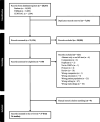Community-based interventions addressing multiple forms of malnutrition among adolescents in low- and middle-income countries: a scoping review
- PMID: 40307813
- PMCID: PMC12044920
- DOI: 10.1186/s12937-025-01136-2
Community-based interventions addressing multiple forms of malnutrition among adolescents in low- and middle-income countries: a scoping review
Abstract
Background: Community-based interventions hold promise for addressing adolescent malnutrition, but there is limited knowledge of their nature and impact on adolescent nutrition outcomes in low- and middle-income countries (LMICs). This scoping review aimed to characterize community-based adolescent nutrition interventions in LMICs and summarize their effects on adolescent nutrition outcomes.
Methods: We systematically searched MEDLINE via PubMed, Embase, and CENTRAL through the Cochrane Library for studies published between 2000 and 2023. The review followed the Preferred Reporting Items for Systematic Reviews and Meta-Analyses Extension for Scoping Reviews guidelines. Eligible studies included randomized controlled trials and quasi-experimental studies addressing adolescent malnutrition in LMIC community settings, involving adolescents aged 10-19 years. A narrative synthesis was employed to analyze and describe the evidence.
Results: Our review included 37 records from 36 studies conducted in 27 countries. Interventions included micronutrient supplementation, nutrition education, food supplementation and fortification, physical activity education, and multicomponent approaches. The intervention duration ranged from 3 weeks to 2 years, with limited studies grounded in theoretical frameworks. Fifty-seven percent of interventions (n = 21) targeted adolescent girls, indicating a gap in programs for boys and other vulnerable groups, such as out-of-school adolescents and migrants. The intervention delivery agents included research staff and healthcare professionals. The majority of interventions were delivered in person; few utilized social media strategies. Among the studies reviewed, nine out of ten evaluating micronutrient supplementation, six out of seven assessing nutrition education, and seven out of eight examining multicomponent interventions reported improvement in at least one nutrition or diet-related outcome.
Conclusions: Community-based interventions hold promise for improving adolescent nutritional status in LMICs. However, our review highlights gaps in the evidence base, marked by significant variability in intervention design, delivery, and implementation platforms. This underscores the need for integrated approaches and rigorous evaluations of their implementation outcomes, including acceptability, relevance, feasibility, effectiveness, and sustainability, in addressing adolescent nutrition challenges.
Registration: The review protocol was registered prospectively with the Open Science Framework on 19 July 2023 ( https://osf.io/t2d78 ).
Keywords: Adolescents; Community interventions; Low- and middle-income countries; Malnutrition; Review.
© 2025. The Author(s).
Conflict of interest statement
Declarations. Ethics approval and consent to participate: Not applicable. Consent for publication: Not applicable. Competing interests: The authors declare no competing interests
References
-
- UNICEF. Adolescents Statistics. 2022. Available at: https://data.unicef.org/topic/adolescents/overview/. Accessed 5 Jan 2024.
-
- United Nations. World Population Prospects 2019 Highlights. 2019. https://population.un.org/wpp/Publications/Files/WPP2019_Highlights.pdf. Accessed 5 Jan 2024.
-
- Global Nutrition Report. 2022 global nutrition report. 2022. https://globalnutritionreport.org/. Accessed 26 Mar 2024.
Publication types
MeSH terms
Substances
Grants and funding
LinkOut - more resources
Full Text Sources
Medical
Miscellaneous


